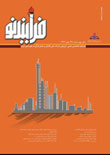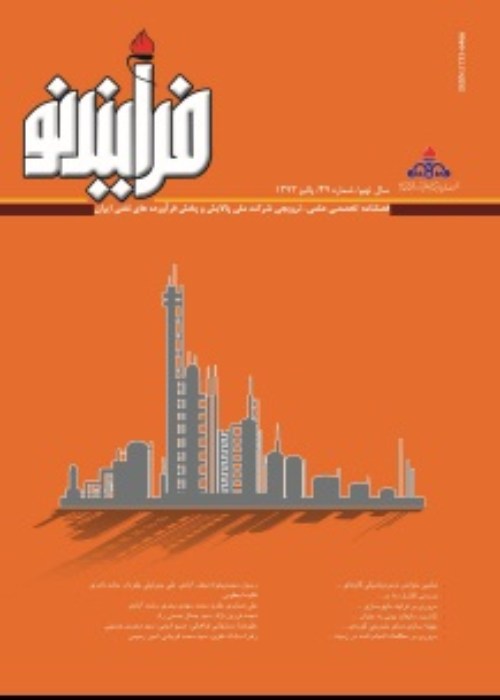فهرست مطالب

مجله فرآیند نو
پیاپی 47 (پاییز 1393)
- تاریخ انتشار: 1393/11/01
- تعداد عناوین: 6
-
-
صفحات 5-23
در این مطالعه معادلات حالت مختلف تجربی، تئوری و شبه تئوری برای سیالات انتخابی متفاوت مورد بررسی قرار گرفته اند و صحت این معادلات جهت تخمین خواص ترمودینامیکی سیالات انتخابی در مقایسه با داده های تجربی مورد سنجش قرار گرفته است. همچنین یک معادله حالت جدید از معادله شبه تئوری محمدیخواه- ابوالقاسمی- محبی استخراج و معرفی شده است. نتایج این تحقیق نشان داده است که معادلات حالت مفروض دقت خوبی در پیش بینی انتالپی و انتروپی سیالات خالص در فشار های اتمسفری و بالاتر دارند بجز برای نرمال بوتان که مقدار خطا زیاد بوده است. همچنین نتایج این مطالعه توافق خوب داده های محاسباتی توسط این معادلات را جهت تخمین ضریب تراکم پذیری سیالات انتخابی با داده های تجربی نشان داده اند. همچنین جهت محاسبه خواص ترمودینامیکی انتالپی و انتروپی در فشارهای کم معادله حالت سوآ - ردلیچ- کوانگ پیشنهاد شده است زیرا کمترین خطا را از خود نشان داده است.
کلیدواژگان: معادلات حالت، انتالپی، انتروپی، صنعت نفت و گاز، خواص ترمودینامیکی -
صفحات 24-36هدف این تحقیق بررسی راه های کنترل دمای راکتور نیمه صنعتی واکنش OCM می باشد. دراین راستا یک ایده جدید برای فرایندOCM پیشنهاد کرده ایم که در آن جریان (split flow mode) می شود و خوراک واکنش OCM شامل هوا و متان قبل از ورود به راکتور تا دمای واکنش گرم میشود. در این طرح راکتور باید تبادل حرارت با محیط در اثر کنوکسیون و تشعشع داشته باشد. روش عبور گاز از میان بستر ذرات جامد، برای گرم کردن خوراک تا دمای بهینه پیشنهادشده است. درراکتور واحد نیمه صنعتی گاز طبیعی در مجاورت هوا تبدیل به اتان و اتیلن می شود که در این راستاراکتور بستر ثابت کاتالیستی OCM از یک لوله با قطر اسمی یک اینچ و بطول یک متر و بیست سانتیمتر تشکیل خواهد شد. طراحی راکتور براساس حرارت آزاد شده 34-43 کیلو کالری به ازای هر مول متان در خوراک انجام شده است.
کلیدواژگان: جفت شدن اکسایشی متان، راکتور بستر ثابت، کاتالیست پروسکایت، افزایش مقیاس -
صفحات 37-50فرایند مایع سازی هیدروژن به دلیل شرایط خاص عملیاتی و تجهیزات مورد استفاده بسیار سخت است. مشکلات موجود به سه بخش هزینه زیاد، بازده کم و عدم توسعه ی روش های جدید برای تولید هیدروژن مایع طبقه بندی می شوند. ماهیت خاص مولکول هیدروژن، شرایط ویژه ی عملیاتی برای مایع سازی آن و استفاده از تجهیزات و موادی که در این شرایط ویژه از کارایی لازم برخوردار باشند، سبب ایجاد چالش های فراوان در مسیر تولید هیدروژن مایع شده است. در این مقاله مروری بر چالش های موجود بر سر راه تولید هیدروژن مایع ارائه می گردد و در هر مورد، به راه حلهای مناسب جهت رفع آن اشاره می گردد.
کلیدواژگان: مایع سازی هیدروژن، هیدروژن مایع، تجهیزات مایعسازی، چالش ها، راه حلها -
صفحات 51-67به دلیل افزایش تقاضای استفاده از روان کننده ها، نیاز به توسعه روان کننده های جدید و بهبود افزودنی ها به شدت احساس می شود. مایعات یونی، نمک های مذاب در دمای اتاق می باشند که اخیرا مزایای بسیار زیادی در این حوزه از خود نشان داده اند. کاربرد مایعات یونی به عنوان روان کننده ها در سیستم های مختلف، موجب بهبود عملکرد آنها در کاهش سایش و اصطکاک نسبت به سایر روان کننده ها شده است. مایعات یونی ترکیبی از یون های نامتقارن بزرگ هستند که می توانند بر روی سطح فلز جذب شده و با ساخت لایه فیلمی محافظ، شرایط روان کاری مرزی را تشکیل دهند. مقاله حاضر مایعات یونی و سیالات روانساز را معرفی نموده و سپس به طور گسترده به ویژگی های روان کنندگی مایعات یونی و همچنین خواص افزودنی آنها به روغن های پایه و سنتتیک می پردازد. در این مقاله ارتباط میان ساختار مایعات یونی و عملکرد آنها در روانکاری بررسی می شود. در انتها نیز برخی مشکلات پیش روی این فناوری جدید و قابلیت های حل آن بحث شده است.
کلیدواژگان: مایعات یونی، افزودنی، روانکار، اصطکاک، لایه فیلمی محافظ -
صفحات 68-76امروزه ریفرمینگ گاز طبیعی با بخار آب یکی از مهم ترین راه های تولید هیدروژن به شمار می رود. از آنجا که واکنش تولید هیدروژن یک واکنش گرما گیر می باشد نیاز به مصرف بالای انرژی کاملا محسوس است. در این کار تحقیقاتی اثر تغییرات دمای عملیاتی کوره ریفرمر پالایشگاه نفت امام خمینی شازند، در ظرفیت های عملیاتی متفاوت، بر راندمان تولید و میزان مصرف انرژی مورد مطالعه قرار می گیرد و راهکاری جهت رسیدن به دماهای بهینه خروجی کوره ریفرمر ارائه می گردد. نتایج نشان می دهد در یک ظرفیت عملیاتی مشخص، با کاهش دما به میزان 10 درجه سانتیگراد، میزان سوخت مصرفی تا NM3/h 200 کاهش می یابد و این در حالی است که جریان خروجی در محدوه استاندارد تعیین شده قرار دارد. همچنین مشاهدات نشان می دهد که نتایج از یک رابطه خطی پیروی می کند.
کلیدواژگان: ریفرمینگ گاز طبیعی، تولید هیدروژن، کاهش مصرف انرژی، دمای عملیاتی کوره ریفرمر بخار، بهینه سازی -
صفحات 77-93هدف از انجام این مطالعه معرفی اجمالی و مقایسه ای روش های بازیابی فلز پلاتین از کاتالیست های مستعمل و مروری بر مطالعات انجام شده در زمینه بازیابی پلاتین از کاتالیست های مستعمل به روش تر (هیدرومتالورژی) می باشد. ابتدا روش تر و انواع آن به تفصیل توضیح داده شده است. سپس مطالعات آزمایشگاهی انجام شده که در آن ها پلاتین موجود در کاتالیست های مستعمل صنعتی و یا کاتالیست های مبدل خودرو به یکی از روش های تر بازیابی شده اند و همچنین مطالعات انجام شده در زمینه بررسی سینتیک فرایند استخراج پلاتین به روش جامد-مایع مرور شده است.
کلیدواژگان: پلاتین، کاتالیست مستعمل، روش تر (هیدرومتالورژی)، استخراج جامد، مایع
-
Pages 5-23
In this study various empirical، theoritical and semi-theoritical equations of state for different optional fluids، have been investigated and the accuracy of these equations for thermodynamic properties estimation of these fluids in comparison with experimental data، was evaluated. Also a new equation of state has been derived from Mohammadikhah-Abolqasemi-Mohebbi semi-theoretical equation and has been introduced. The results of this research have showed that assumed equations of state have good accuracy in predicting the enthalpy and entropy for pure fluids in atmospheric pressures and slightly higher، except for n-butane which the error was high. Also، results of this research have showed good agreement between calculated data from these equations for compressibility factor prediction of optional fluids with experimental data. Also soave-redlich-kwong equation of state has been recommended for calculating thermodynamic properties including enthalpy and entropy at low pressures، because it has showed minimum errors.
Keywords: Equations of state, Enthalpy, Entropy, Oil, gas industry, Thermodynamic properties -
Pages 24-36In this research some aspect of temperature control in pilot reactor was investigated. The split flow mode procedure was proposed، in which the temperature of feed gas، containing methane and oxygen، were reached to favorite reaction temperature before entrance to reactor. For the reason of highly exothermic of partial oxidative reaction، the important problem will be removal of heat flux from reactor body. In this research reactor was exposure in heat transfer with environment through radiation and convection. The passing of gas through the packed bed was used for reaching feed gas temperature to the optimum range. In this way OCM reactor was performed in isothermal operation and has high potential for heat removal. The reactor designed for diameter of 1 in and length of 125 cm.Keywords: OCM, Fixed Bed Reactor, Perovskite Catalyst, Scale Up
-
Pages 37-50Hydrogen liquefaction process is a complex operation due to the special equipment and operational conditions used. The challenges involved are classified into three divisions as follow: high costs، low efficiency، and lack of the development of new approaches to produce liquid hydrogen. The peculiar nature of molecules of hydrogen، particular operational conditions of the hydrogen liquefaction process، and the use of appropriate equipment and materials operated under these conditions، cause many obstacles in the development of liquid hydrogen production. In the current study، a review on the challenges of the liquefaction of hydrogen is presented and appropriate solutions are suggested for each of them.Keywords: Liquefaction of hydrogen, liquid hydrogen, liquefaction equipment, challenges, solutions
-
Pages 51-67Due to increased demands on lubricants، there is a need to develop new lubricants and improved additives. Ionic liquids (ILs) are room temperature molten salts that have recently shown many advantages in this area. The application of ILs as lubricants in a diverse range of systems has found that these materials can show remarkable protection against wear and reduction of friction. ILs consists of large asymmetrical ions that can readily adsorb onto a metal surface and produce a protective film under boundary lubrication conditions. This article starts with a brief introduction to ILs and fluid lubrication، and then discusses in more detail the tribological properties of IL lubricants، either as base and synthetic oil additives. In this article the correlation between the IL structure and their performance in tribology applications is examined. Finally، some current problems and potential solutions are discussed.Keywords: Ionic Liquids, Additive, Lubricant, Friction, Protective film
-
Pages 68-76Nowadays، natural gas reforming by steam is and important technique for hydrogen production. According to the fact that reaction of hydrogen production is an endothermic reaction، high energy consumption is required. In this research، the effect of operating temperature of furnace reformer unit in various capacities on productive efficiency and energy consumption of this unit was studied. Also an appropriate procedure was recommended for optimization of furnace reformer temperature. The obtained results showed that in a special capacity by decreasing of furnace reformer temperature up to 10 oC the consumed fuel was declined up to 200 NM3/h whereas the outlet stream located in standard specifications. Also results exhibited linear trend for the optimization.Keywords: Natural gas reforming, Hydrogen production, Energy consumption reduction, Operating temperature of furnace reformer, Optimization
-
Pages 77-93The petroleum and petrochemical industries produce considerable amounts of spent catalysts. The platinum group metals (PGMs) exhibit excellent catalytic activity. Their excellent selective and activity make them very effective catalysts. Catalysts, after a certain period of active life and regeneration cycles, are deactivated. The aim of the present study is to introduce and compare the wet-base (hydrometallurgy) methods used for extraction of platinum from spent catalysts. First, the principles of wet method and its kinds are introduced. Then, the previous experimental studies in which the extraction of platinum from autocatalysts and spent catalysts of chemical industries has been studied, are reviewed and compared in terms of operating conditions, materials, economic and environmental aspects.Keywords: Platinum, Spent Catalyst, Hydrometallurgy Method, Solid, Liquid Extraction


